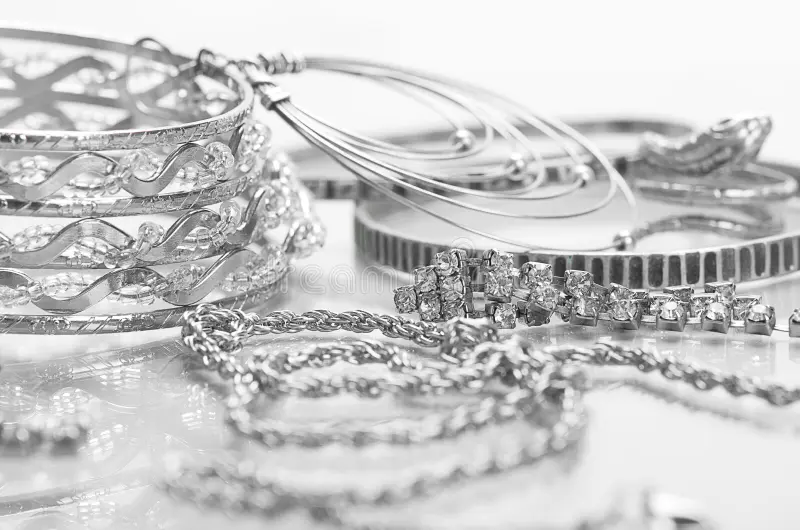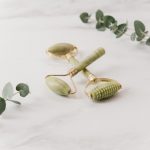Humans have long been entranced by sparkling silver: as jewelry, coinage, high-status homewares, and status symbols. Silver is often used to celebrate milestones, achievements, celebrations, and ceremonies and for its beautiful ornamental value.
But how much do you really know about silver and your silver jewelry? What is sterling silver anyway? Why does silver tarnish, and how can you clean it? How is silver different from gold? And why should you care?
In this guide, we will delve into the fascinating world of silver, exploring its history, properties, care, and why it remains a popular choice for jewelry. So, let’s get started…
Table of Contents
1. Silver: The Lowdown
– Introduction to Silver
– Composition and Characteristics
– History of Silver Usage
2. What is Sterling Silver?
– Understanding Sterling Silver
– Alloying with Copper
– Tarnishing of Sterling Silver
3. About Silver Jewelry
– The Excellence of Sterling Silver Jewelry
– Care and Cleaning Tips
– Suitability for Gemstone Settings
4. Silver or Gold Jewelry?
– Comparing Silver and Gold
– Factors to Consider
5. How Do You Know Your Jewelry Is Real Silver?
– Hallmarks and Stamps
– The Magnet Test
– The Bleach Test
– Using Precious Metal Testing Kits
6. A Warning About Nickel Silver and German Silver
– Concerns About Nickel and German Silver
– The Importance of Nickel-Free Jewelry
7. The Parting Shot
– The Beauty and Versatility of Silver Jewelry
– Longevity and Value of Silver
Silver: The Lowdown

Introduction to Silver
Silver is a precious metal that has fascinated humans for centuries. Alongside gold, copper, tin, lead, iron, and mercury, silver is one of the seven metals known to prehistoric humans. Its captivating shine and malleability made it highly sought after in ancient times.
Composition and Characteristics
Silver is a soft, ductile, and malleable metal like gold and copper. While not as hard as gold, it finds various applications to increase its hardness, especially when alloyed with other metals.
History of Silver Usage
The history of silver’s discovery and early use remains mysterious due to its ancient origins. However, it gained prominence around 1500 BC when the Egyptians discovered new refining methods, making it more accessible.
What is Sterling Silver?
Understanding Sterling Silver
Sterling silver is a form of alloyed silver that is more suitable for jewelry and metalwork. Fine silver, with 99.9% purity, is too soft for most applications, including jewelry making. Thus, it is mixed with copper to create sterling silver, which has 92.5% silver and 7.5% copper.
Alloying with Copper
Adding copper makes sterling silver harder and more durable while preserving its beautiful color. You may encounter the term ‘925 silver’ or see a 925 stamp on sterling silver, indicating its 92.5% silver content.
Tarnishing of Sterling Silver
Sterling silver may tarnish over time, especially in humid conditions, due to the presence of copper. However, regular cleaning can easily restore its original luster.
About Silver Jewelry
The Excellence of Sterling Silver Jewelry
Sterling silver jewelry is an excellent choice for most circumstances. It does not rust or perish with normal use, and with proper care, it can be passed down through generations. However, it may not be suitable for expensive gemstone settings due to its softness.
Care and Cleaning Tips
Taking care of sterling silver jewelry is essential. Harsh cleansers should be avoided, as they can damage the metal over time. There are specific methods to clean and maintain your silver jewelry properly.
Suitability for Gemstone Settings
Due to its softness, sterling silver is less suitable for settings with valuable gemstones. For such cases, harder metals like gold or platinum are preferred to keep the settings intact.
Silver or Gold Jewelry?
Choosing between silver and gold jewelry is primarily a matter of personal preference and budget. Silver is significantly less expensive than gold, mainly because it is more abundant in nature.
How Do You Know Your Jewelry Is Real Silver?
Hallmarks and stamps like “925” or “999” usually indicate real silver. However, not all silver jewelry is hallmarked. You can perform alternative tests to determine if your jewelry is genuine silver.
A Warning About Nickel Silver and German Silver
Nickel silver and German silver are not genuine silver and may cause allergic reactions in some individuals. It is essential to avoid wearing jewelry made from these metals and instead opt for nickel-free and genuine sterling silver jewelry.
The Parting Shot
Silver jewelry, with its warm color and elegance, complements almost anyone. Its value is likely to appreciate over time, and it is endlessly recyclable, making it an eco-friendly choice. By choosing silver jewelry, you add style, value, and versatility to your collection, making it an excellent choice.
Conclusion
Silver jewelry has a timeless allure, from its rich history to its lustrous shine. Understanding the difference between fine silver and sterling silver helps you appreciate the beauty of this precious metal even more. Embrace the elegance of silver and cherish its enduring qualities.
FAQs (Frequently Asked Questions)
1. Is sterling silver real silver?
– Yes, sterling silver is a form of real silver alloyed with copper for durability.
2. How can I clean tarnished silver jewelry?
– There are various methods to clean tarnished silver, such as using a polishing cloth or a silver dip.
3. Why is silver less expensive than gold?
– Silver is more abundant in nature than gold, leading to its lower cost.
4. Is sterling silver suitable for gemstone settings?
– While sterling silver is generally durable, it may not be the best choice for expensive gemstone settings due to its softness.
5. Is silver jewelry a good investment?
– Silver jewelry can retain its value and even appreciate over time, making it a wise investment choice.






GIPHY App Key not set. Please check settings